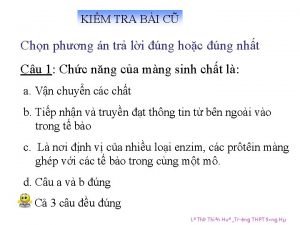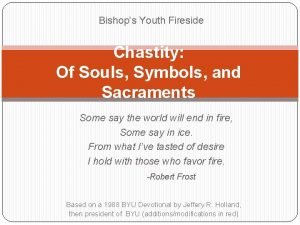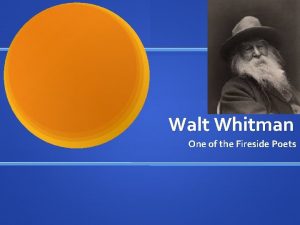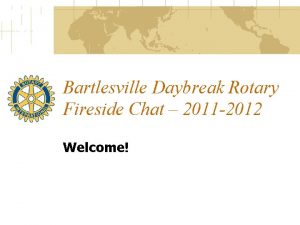CS Department Fireside Chat All are welcome Wed










![! n e op l l i t S ÎP [2004] ! n e op l l i t S ÎP [2004]](https://slidetodoc.com/presentation_image/4b3f470f877965244c7681a2ff89c299/image-11.jpg)














- Slides: 25

CS Department Fireside Chat All are welcome! Wed Nov 18, 5 -6 pm, Ols 228 e/236 d Kim Hazelwood and Wes Weimer Meet and ask them questions in a non-academic setting. Learn how they became interested in computer science, what they wish they had known when they were students, and what their lives are like outside of the office. Ask them anything!

from “Complexity of Computer Computations”, pp. 85– 103, 1972.




e t e l p g i r O f. N o in m o C P- ! s s ne




PSPACE-complete P N n i p n! i h s r ope e b m still e M is
![n e op l l i t S ÎP 2004 ! n e op l l i t S ÎP [2004]](https://slidetodoc.com/presentation_image/4b3f470f877965244c7681a2ff89c299/image-11.jpg)
! n e op l l i t S ÎP [2004]

Problem Transformations Idea: To solve a problem, efficiently transform to another problem, and then use a solver for the other problem: Satisfiability (x+y)(x'+y') Colorability SAT solution x=1, y=0 Colorability solver

Decision vs. Optimization Problems Decision problem: “yes” or “no” membership answer. (x+y+z) Ex: Given a Boolean formula, is it satisfiable? ^(x'+y'+z) ^(x'+y+z') Ex: Given a graph, is it 3 -colorable? Ex: Given a graph & k, does it contain a k-clique? Optimization problem: find a (minimal) solution. Ex: Given a formula, find a satisfying assignment. Ex: Given a graph, find a 3 -coloring. Ex: Given a graph & k, find a k-qlique. Theorem: Solving a decision problem is not harder than solving its optimization version. Theorem: Solving an optimization problem is not (more than polynomially) harder than solving its decision version.

Decision vs. Optimization Problems Corollary: A decision problem is in P if and only if its optimization version is in P. Corollary: A decision problem is in NP if and only if its optimization version is in NP. Building an optimizer from a decider: yes Satisfiability Decider no Ex: what is a satisfying assignemnt of P=(x+y+z)(x'+y'+z)(x'+y+z') ? Idea: Ask the decider 2 related yes/no questions: P P^x Iterate! Satisfiability P^x' Decider Satisfiability Decider yes no x is true x is false Satisfiability Optimizer x is “don’t care” P is not satisfiable

Graph Cliques Graph clique problem: given a graph and an integer k, is there a subgraph in G that is a complete graph of size k? Theorem: The clique problem is NP-complete. Proof: Reduction from 3 -SAT: Literals become nodes; k clauses induce node groups; Connect all inter-group compatible nodes / literals. Example: (x+y+z)(x'+y'+z)(x'+y+z') X' Y' Z Graph clique solver X X' Y Y Z Z' k-clique corresponds to 3 -SAT solution: x = true, y = false, z = false Clique is in NP Þ clique is NP-complete.

Independent Sets Independent set problem: given a graph and an integer k, is there a pairwise non-adjacent node subset of size k? Theorem: The independent set problem is NP-complete. Proof: Reduction from graph clique: Idea: independent set is an “anti-clique” (i. e. , negated clique) Þfinding a clique reduces to finding an independent set in the complement graph: Independent set ÎNP Þ NP-complete. Graph clique solver Independent set solver


Graph Colorability Problem: is a given graph G 3 -colorable? Theorem: Graph 3 -colorability is NP-complete. Proof: Reduction from 3 -SAT. Idea: construct a colorability “OR gate” “gadget”: (x+y+z) Þ x x y x' "x T z T Property: gadget is 3 -colorable iff (x+y+z) is true F

x+y+z x'+y'+z x'+y+z' Example: (x+y+z)(x'+y'+z)(x'+y+z') x x y T y z z T x' F y' T x "x x' z' F

x+y+z x'+y'+z x'+y+z' Example: (x+y+z)(x'+y'+z)(x'+y+z') 3 -colorability Solution: 3 -satisfiability Solution: x = true y = false z = false x y z x' y' T z' F ” F “ s i : ? t y i r d a e ess r c a nec r t x E ode n

What Makes Colorability Difficult? Q: Are high node degrees the reason that graph colorability is computationally difficult? A: No! Graph colorability is easy for max-degree-0 graphs Graph colorability is easy for max-degree-1 graphs Graph colorability is easy for max-degree-2 graphs Theorem: Graph colorability is NP-complete for max-degree-4 graphs.

Restricted Graph Colorability Theorem: Graph 3 -colorability is NP-complete for max-degree-4 graphs. Proof: Use “degree reduction” gadgets: 3 -colorability constraint propagation: Properties: a) Gadget has max-degree of 4 b) Gadget is 3 -colorable but not 2 -colorable c) In any 3 -coloring all corners get the same color

Restricted Graph Colorability Idea: combine gadgets into “super nodes”! Local node replacement: High degree Max degree 4 Properties (inherited from simple gadget): a) Super-node has max-degree of 4 b) Super-node is 3 -colorable but not 2 -colorable c) In any 3 -coloring all “corners” get the same color Idea: Use “super nodes” as “fan out” components to reduce all node degrees to 4 or less

Restricted Graph Colorability Example: convert high-degree to max-degree-4 graph Max degree 6 Max-degree-4 colorability solver Max degree 4 Conclusion: Solving max-degree-4 graph colorability is as difficult as solving general graph colorability!

Restricted Graph Colorability Theorem: Graph 3 -colorability is NP-complete for planar graphs. Proof: Use “planarity preserving” gadgets: v l o S s i h e t e r fo c a xtr ! t i red
 Antigentest åre
Antigentest åre I love the fireside when all the lights are low
I love the fireside when all the lights are low Vận chuyển các chất qua màng sinh chất
Vận chuyển các chất qua màng sinh chất Bishop youth fireside
Bishop youth fireside Short fireside poems
Short fireside poems Henry david thoreau romanticism
Henry david thoreau romanticism Fireside poets
Fireside poets Fireside poets definition
Fireside poets definition Arbitration apush
Arbitration apush Name all the lines name all the segments name all the rays
Name all the lines name all the segments name all the rays Welcome transport department
Welcome transport department Wise men three clever are we
Wise men three clever are we Welcome to english class
Welcome to english class Welcome to all delegates
Welcome to all delegates Welcome all delegates
Welcome all delegates Hearty welcome to all
Hearty welcome to all Welcome to all participants
Welcome to all participants Welcome to all participants
Welcome to all participants Welcome to all participants
Welcome to all participants Welcome to all delegates
Welcome to all delegates Welcome to all delegates
Welcome to all delegates Welcome to all participants
Welcome to all participants Wafwa chat
Wafwa chat Wicked cam chat
Wicked cam chat Xyy syndrome
Xyy syndrome Natacha natacha pas son chat pacha
Natacha natacha pas son chat pacha

















































